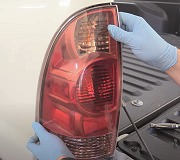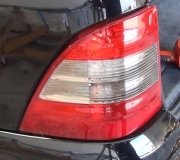Your car is old enough to still use the common sense thermal flasher. Those require a certain amount of current flow through them to make them flash. Two things can happen to reduce that current too much. One is a burned out bulb, or a bulb that isn't getting switched into the circuit by the turn signal switch. The second is a broken ground circuit.
Broken ground symptoms can be very confusing or misleading when you have to run to the signal switch, then run in back to see what's happening. It works better to have a helper run the switch, allowing you to watch what changes around the car. Specifically, watch for incorrect operation of the rear signal lights. Also watch if both sides look exactly the same when the four-way flashers are on.
One often overlooked clue is the tail light and / or the signal light on the non-flashing corner isn't as bright as the bulb on the working side. You have to watch both sides at the same time to pick that up. When you do see that, leave the running lights turned on, then watch what happens to the right rear bulb(s) when you unplug the bulb(s) on the left side. If doing that makes the right bulb go out, it has a bad ground.
What happens is current tries to flow through the right bulb, but can't find its way back to ground, so it travels over to the corresponding circuit on the left side, goes through that bulb, then to ground on the left side. By removing the left bulbs, you remove that alternate ground path for the right bulbs.
Another clue to watch for is the non-flashing bulb may light up for the tail light, then flash off instead of brighter when the signals are on. When that happens with the four-way flashers, the left rear lights will flash bright while the right ones go off. They do the opposite of each other instead of flashing identically.
So far this is just a lot of observations, but no real diagnosis. If you identify the bulb that isn't lighting up properly, start by following its wires to where one is bolted to the body sheet metal. Look for one that's corroded off. One more thing to look at if the problem is on the rear is if the license lamp is working. They often share a ground circuit with one of the rear tail lights.
The next thing to consider is around this time GM was experimenting with aluminum wire. The insulation was translucent, and you could see through it to the actual wire. They had huge problems with corrosion. One big problem area was the fuse box. It sits just in front of the brake pedal where snow and salt get in there from your feet. The terminals, wires, and rivets were aluminum, copper, and brass. Two different kinds of metal, with an acid, (salt) forms "galvanic action" similar to what takes place with the acid in a battery. That leads to lots of intermittent connections. I've found a few of these by wiggling the wire harness while circuits were turned on, and seeing small sparks occurring behind the fuse box.
Another thing to be aware of is it is never a good idea to pierce a wire's insulation to take a voltage reading. Doing so will lead to corroded copper wire within a few years. With this aluminum wire, the hole will let moisture in turning the wire to powder within a few weeks. That is real difficult to repair except by replacing the entire length of wire. Aluminum wire can't be soldered to, and you can't really crimp connectors to it and seal it with expecting it to keep moisture out.
At the moment I haven't found a wiring diagram to look at, so I'm doing part of this from memory. GM was the only manufacturer that tried to combine the front signal light with the front side marker light, into the signal system. They ran both bulbs in series for the running lights. The side light was a small 194 "peanut" bulb that required very little current, so it looked to be full, normal brightness. The larger front bulb was running on the same current that was too low, so the bright signal part appeared to be the normal lower brightness running light. That was with just the running / tail lights on. When the signals were switched on, the flasher pulsed to short out the smaller side marker light. That gave full voltage to the larger signal bulb, so it flashed full brightness at the same time the side bulb flashed off. That made for a very distinctive front signal system, but with all kinds of new potential problems. If you have that on your car, be sure both bulbs in the front are okay.
If you haven't found this by now, I'll search for the diagram, then we'll need to take some voltage readings to see what's happening.
Sunday, December 18th, 2022 AT 6:14 PM



